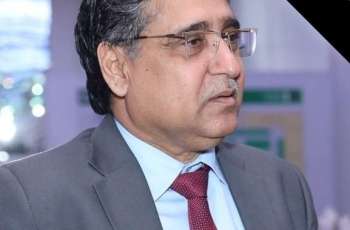Unbridled population growth and insufficient development of health facilities had brought about a distressing effect on public healthcare system making thousands of patients wait for important surgeries till months
By Dr. Saeed Ahmad Ali :
Unbridled population growth and insufficient development of health facilities had brought about a distressing effect on public healthcare system making thousands of patients wait for important surgeries till months.
With overburdening public sector hospitals, people are left with no other choice to approach private hospitals paying extra money for their treatment that is sometimes beyond their affordability.
Catering to the needs of ailing people visiting public sector hospitals daily in bulk not only deteriorates the treatment level but also becomes hectic for medical professionals who have to check thousands of patients daily at each major facility.
Although some progress was made in this sector in recent years in the Punjab province yet it was not compatible to population growth. Therefore, heavy rush is witnessed very often at the public sector hospitals' outdoor facilities.
“Unhealthy lifestyle, lack of awareness to lead hygienic life and poor purchasing power, especially among the poor communities had resulted in the ailment of more and more people,” remarked former Medical Superintendent (MS) of Mayo Hospital, Dr. Iftikhar Ahmed.
“Since our facilities are already overburdened, resurgence of diseases like dengue, COVID-19, malaria, pneumonia and tuberculosis further deteriorate the level of treatment,” he stated.
Dr Iftikhar said majority of people also lack basic amenities of life like clean drinking water and sanitation and are unaware of the precautionary measures against preventable and infectious diseases. “The challenge of dispensing quality healthcare to people, needs more allocations for the sector and address multiple issues like healthier environment and pure food.”
If we see the most populous province of Punjab that inhabits around 120 million people, there are 34 District Headquarter Hospitals (DHQs), 88 Tehsil Headquarter Hospitals (THQs) and 23 teaching hospitals in the public sector.
Although, there is also large number of Basic Health Units but majority of them are either nonfunctional or doctors deputed there occasionally visit these facilities making even ordinary patients approach the main facilities in big cities.
As most of the public sector hospitals are not maintained hygienically, therefore patients admitted at these facilities often come across stinky washrooms and dirty corridors that expose them to additional infections.
Muhammad Noor, a patient admitted to Mayo Hospital OPD said that doctors are not giving proper attention and treatment to the bulk of patients. “Doctors do not take interest in their duty because their major focus is always to bring these patients to their private clinics.”
He said the senior doctors visit the admitted patients once a week and this is real dilemma with the system. “Most of time there is room for patients and in many cases two patients are provided one bed or they have to arrange their cots for laying in the corridors.
”
Established in 1871, Mayo Hospital is the biggest hospital in the city with 2800 beds capacity but it often falls short due to patients’ pressure.
Commenting on the situation, Professor Dr. Muhammad Amjad E.N.T specialist at Adil Hospital agreed that despite the allocation of millions of rupees for the health sector, hospitals of provincial metropolitan lack state-of-the-art treatment facilities.
“Patient most often face inconvenience due to unavailability of proper facilities including shortage of paramedical staff and life-saving drugs and latest equipment,” he said.
He said since population of the city has risen manifold in recent decades, 11 teaching hospitals and 13 THQs in the metropolitan face enormous burden of patients.
Approximately 3000 patients visit the Outdoor Patient Department (OPD) of Mayo Hospital daily basis but staff deputed for their treatment was quite insufficient.
Muhammad Usman, Special Secretary Development and Reforms at Specialized Healthcare and Medical education Department Punjab has also acknowledged that despite extensive and elaborate healthcare facilities, the delivery system faces issues like insufficient funds and staff.
,
“Our infrastructure could not grow in compatibility with the rapid population growth that over burdened existing infrastructure,” he said. “Since, check up fees and treatment charges at public hospitals are cheaper and in some cases medicine is provided free of cost, therefore these facilities remain flooded with poor and low income groups.”
Although, the public sector health facilities flourished in terms of physical infrastructure and increased numbers of doctors and other staff yet there are still issues like inconsistent and uneven distribution of health professionals, insufficient funding, deficient workforce and limited access to quality healthcare.
As the patients and professionals both complain of paucity of funds and insufficient staff, Punjab government Spokesperson Musarrat Jamshed Cheema has claimed that the provincial government is taking corrective measures to improve the healthcare system in the province.
“The Punjab Chief Minister in July this year approved up-gradation of emergency wards of all public hospitals across the province also announcing free-of-cost medicines to the patients,” she informed.
“Moreover, 23 large government hospitals are built in the province to meet the needs of growing population,” she said also mentioning to decision of increasing beds at Wazirabad Institute of Cardiology to 400.
She said the government has also announced provision of best healthcare to people in partnership with the private sector. “The government has also extended Health Card Program as getting free medicines in emergencies, is basic right of patients.”
She said Mother and Child block at Gangaram Hospital Lahore is in the final stage of completion and 11 more mother and child hospitals are being built at different hospitals to ensure better health facilities for women and children.



